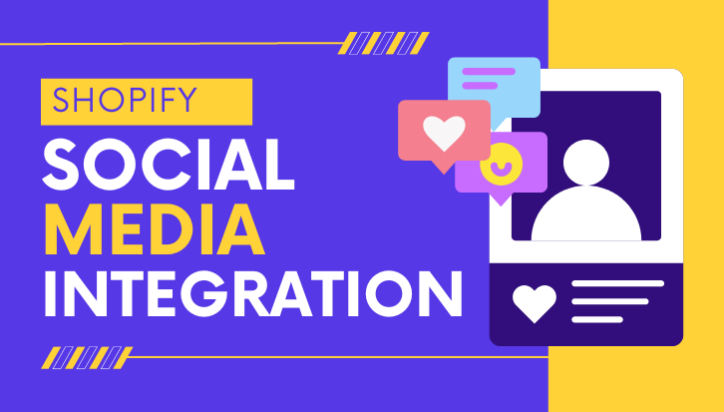
Shopify Social Media Integration: A Step by Step Guide
If you have brand new to Shopify or running your business via Shopify, chances are that you are already using social media platforms like Facebook or Instagram to your advantage.
Now the question is, would you like to take your social media marketing efforts to new heights? Or did you consider integrating your social media profiles?
If so, here comes the point of integrating your social media accounts with your Shopify website. Because alongside its diverse array of tools and functions, Shopify showcases the capacity to integrate seamlessly with a variety of social networks.
Curious about the reason behind integrating your social media account with your storefront and the whole process? Read on to learn more.
Why link your social media account to your Shopify store?
First, if we discuss the perks of Shopify social media integration, it turns out there are many. From providing more convenience to customers to boosting the efficiency of your workflows, connecting your Shopify store with your social media accounts can offer you enhanced reach and efficiency while saving you valuable time and effort.
You can reach a qualified demographic who already follows your social media sites. And this will maximise the likelihood for them to click your links or read your posts, leading to desired actions like spot-on purchases. Moreover, the incorporation of social media will foster a sense of community around your brand by interacting with your audience through comments, messages or engaging posts.
You can even take advantage of several advertising options offered by social media channels to drive sales on your Shopify store. Alongside promoting your products and services, you can explore your competitors better and understand their strategies.
How to connect social media account with Shopify?
One thing is clear. You can unlock a multitude of benefits, including a surge in followers, impressions, awareness and engagement, by incorporating social media integrations.
Now you might be thinking of which social media platform to join to get the most out of it. From Facebook to Snapchat to LinkedIn, you can pick any.
Let’s look at some of the popular Shopify social media integrations.
1. Facebook

Merging your Shopify account with Facebook, you can unlock the potential to connect with a massive pool of users. This integration will empower you to effortlessly display your products to potential customers, seamlessly appearing on their newsfeeds and prominently within the Facebook Marketplace.
First, you need to have a Facebook account and an online store first to sync your online store with Facebook.
Let’s look at how you can integrate your Shopify store with Facebook.
- Go to your Shopify admin dashboard and click Settings > Apps and Sales channels.
- Click Shopify App Store. Scroll down and select Facebook to learn more about the sales channel.
- Click on the Add Channel button.
- Then connect your Facebook account by clicking on the Connect Account button.
- You can customise your Facebook shop by picking the collections, products or images you want to showcase.
- Once you accept the terms and conditions, you click Finish Setup.
- When the Facebook shop is set up, it will automatically sync with your Shopify store.
Note: As Facebook and Instagram apps are linked, you will be automatically integrating Instagram with Shopify the same way.
2. Pinterest

Pinterest is a wonderful social media tool to use because of its unique visual format and works well for businesses, and appeals predominantly to females. By syncing your products to your Pinterest business account, you can reach more people and retarget the people they have engaged with your pins. You can sell on Pinterest with Shopify. You can claim the Shopify store on Pinterest and watch insights about your pins as well.
Before Pinterest Shopify integration, you must have a Pinterest account.
- From your Shopify page admin, go to Shopify App Store and go to the Pinterest app.
- Review the permissions and click on the Add Channel button.
- Connect your Pinterest account by clicking on the Connect Account button.
- Customise your rich pins by selecting your prime products or exclusive collections to showcase through detailed explanations and eye-catching imagery.
- Discover options like Promoted Pins or Shopping ads to maximise brand prominence.
Or, in case you don’t have Pinterest for the Shopify app, you can install the tag manually as well. Click here to learn in detail.
3. X (Formerly Twitter)

With Shopify’s X (Formerly Twitter) professional profiles, you can display your products, with each item redirecting users to the Shopify product page. By connecting your X (Formerly Twitter) account to your Shopify admin, you can take advantage of Twitter’s Shopping Manager and automatically sync inventory features. You can showcase your products front and centre on your X (Formerly Twitter) profiles.
With only a few simple steps, you can set up the X (Formerly Twitter) sales channel on Shopify.
- Log into your Shopify admin account and navigate to the Sales Channel tab.
- Click on the + button to add a new sales channel.
- Select Twitter, enter your account information and click on the Connect Account button.
- Then connect to Twitter Shopping Manager, where you can manage how your business shoppable content appears on Twitter.
- Once done, click Finish Setup at the bottom right.
Time to get started with linking social media with Shopify
Creating a strategy is key when connecting your Shopify store with social media accounts. It should clearly mention what you want to achieve.
1. Set social media goals
The goal can be to enhance brand visibility, stimulate product demand, secure valuable leads, boost website traffic, drive sales, collaborate with influencers, foster a trustworthy follower base, establish social credibility, or foster a vibrant customer community. But make sure that the strategic move should be aligned with these objectives so that you can achieve an impactful outcome.
2. Consider your customers
It’s absolutely essential to pinpoint your potential customers so you can pick the right social media platform. Try to identify the ideal age group or gender of your potential customers. Thoroughly survey and dissect the market landscape to gain invaluable insights into people’s preferences. By putting yourself in your customers’ shoes, you can craft messages that resonate with them, focusing on their preferences and interests.
3. Run a social media audit
Instead of starting anew, build upon what you’ve already established. Look at your current accounts and engagement level to get a clear idea of which account to maintain or initiate. Try to assess indicators of your social media initiatives, such as likes, social interactions, follower count, engagement rates, social shares, and conversion rates and have a comprehensive understanding of your campaign’s efficiency. Also, don’t forget to safeguard against imposter accounts that could harm your brand integrity.
4. Create compelling content
To establish a compelling online presence, consistent updates across social media platforms are of the greatest importance. Continuously create attractive, informative and unique content that resonates with your audience. Decide everything prior, from what you want to say to how you want to say it to how often you want to post. Analyse your competitors to uncover new ways to engage clients.
Wrapping up
As the team of Spotify made sure that the platform worked with all the major social media platforms, it’s high time to integrate your Shopify store with your preferred social media platform to boost your store’s reach, visibility and revenues! Simply embed the convenient Buy button across your Facebook page, Pinterest board or Twitter profile and enable your followers to discover and purchase your products without visiting your store. But make certain that you follow a clear and strong strategy.
You read a lot. We like that
Want to take your online business to the next level? Get the tips and insights that matter.

